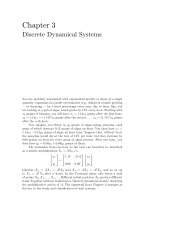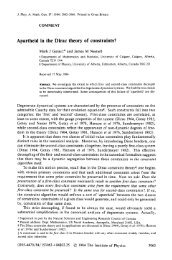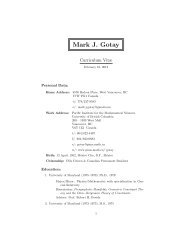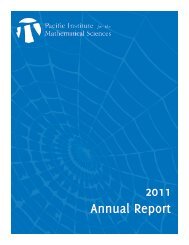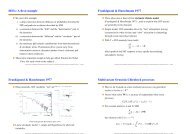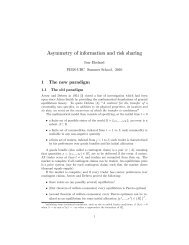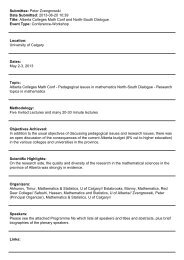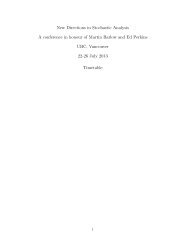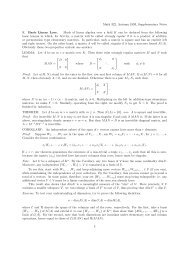27 PRIMA 2013 Abstractsis well-known th<strong>at</strong> for each r<strong>at</strong>ional map f on Ĉ withdeg(f) ≥ 2, the Julia set J(f) is a non-empty perfect compactsubset of Ĉ (thus J(f) contains uncountably manypoints), f : J(f) → J(f) is chaotic (<strong>at</strong> least in the senseof Devaney), anddim H ({x ∈ Ĉ | lim infn→∞ 1 n log ‖Df n (x)‖ > 0}) > 0,where dim H denotes the Hausdorff dimension with respectto the spherical distance on Ĉ and ‖ · ‖ denotesthe norm of the deriv<strong>at</strong>ive with respect to the sphericalmetric on Ĉ. However, we show th<strong>at</strong> for generic i.i.d.random dynamical systems of complex polynomials, allof the following (1) and (2) holds.(1) For all points x ∈ Ĉ, the orbit of the Dirac measureδ x <strong>at</strong> x under the dual of the transition oper<strong>at</strong>or ofthe system converges to a periodic cycle of probabilitymeasures on Ĉ.(2) For all but countably many points x ∈ Ĉ, for almostevery sequence γ = (γ 1 , γ 2 , γ 3 , · · · ) of polynomials,the Lyapunov exponent along γ starting with x isneg<strong>at</strong>ive. More precisely, there exists a constantc < 0, which depends only on the system, such th<strong>at</strong>for all but countably many points x ∈ Ĉ, for almostevery sequence γ = (γ 1 , γ 2 , γ 3 , · · · ) of polynomials,1χ(γ, x) := lim n→∞ log ‖D(γn ◦ · · · ◦nγ 1 )(x)‖ exists and χ(γ, x) ≤ c.Note th<strong>at</strong> each of (1) and (2) cannot hold in the usualiter<strong>at</strong>ion dynamics of a single r<strong>at</strong>ional map f withdeg(f) ≥ 2. Therefore the picture of the randomcomplex dynamics is completely different fromth<strong>at</strong> of the usual complex dynamics. We remarkth<strong>at</strong> even the chaos of the random system disappears inC 0 sense, the chaos of the system may remain in C 1 sense,and we have to consider the “grad<strong>at</strong>ion between the nonchaoticityand the chaoticity”.References[1] H. Sumi, Random complex dynamics and semigroupsof holomorphic maps, Proc. London. M<strong>at</strong>h. Soc. (2011),102 (1), 50–112.[2] H. Sumi, Cooper<strong>at</strong>ion principle, stability andbifurc<strong>at</strong>ion in random complex dynamics, preprint,http://arxiv.org/abs/1008.3995.The semi-classical zeta function for contactAnosov flowMas<strong>at</strong>o TsujiiKyushu University, Japantsujii@m<strong>at</strong>h.kyushu-u.ac.jpWe consider the semi-classical (or Gutzwiller-Voros) zetafunction for a C ∞ contact Anosov flow. This is definedby the formula⎛⎞Z sc(s) = exp ⎝− ∑ ∞∑ e −s·m·|γ|⎠m · | det(Id − Dγ∈Γ m=0γ m)|1/2 where Γ is the set of prime periodic orbits. (|γ| and D γdenote the prime period and the transversal Jacobian ofγ ∈ Γ respectively. )Investig<strong>at</strong>ing the spectrum of transfer oper<strong>at</strong>ors associ<strong>at</strong>edto the flow, we prove th<strong>at</strong> the zeros of Z sc(s) arecontained in the region{s ∈ C | |R(s)| < τ or R(s) < −χ 0 + τ}for arbitrarily small τ > 0 up to finitely many exceptions,where χ 0 is the hyperbolicity exponent of the flow. Furtherwe show th<strong>at</strong> the zeros in the strip {s ∈ C | |R(s)|
28 PRIMA 2013 AbstractsQuantum, kinetic and hydrodynamic descriptionson spin transfer torqueCarlos J. García-CerveraUniversity of California, Santa Barbara, USAcgarcia@m<strong>at</strong>h.ucsb.eduMagnetic storage devices rely on the fact th<strong>at</strong> ferromagneticm<strong>at</strong>erials are typically bistable, and th<strong>at</strong> it is possibleto switch between diïňĂerent st<strong>at</strong>es by applying amagnetic ïňĄeld. The discovery of the Giant MagnetoResistanceeïňĂect has enabled the use of layered ferromagneticm<strong>at</strong>erials in magnetic devices, such as magneticmemories (MRAMs). Even in the absence of thermaleïňĂects, there are limit<strong>at</strong>ions in the storage capacity ofsuch devices due to the fact th<strong>at</strong> as the size is decreased,the magnitude of the switching ïňĄeld increases, due toan increase in shape anisotropy. Given th<strong>at</strong> magneticïňĄelds have long range interactions, the density of suchdevices is limited.A new mechanism for magnetiz<strong>at</strong>ion reversal in multilayerswas proposed by Slonczweski and Berger. In thisnew mechanism, an electric current ïňĆows perpendicularto the layers. The current is polarized in the ïňĄrstlayer, and the polariz<strong>at</strong>ion travels with the current to thesecond layer, where it interacts with the underlying magnetiz<strong>at</strong>ion.Since currents are localized in each cell, longrange eïňĂects can be reduced.In this talk we will discuss the connection between severalmodels for the description of the spin transfer torque<strong>at</strong> different physical scales. Specifically, we connect thequantum and kinetic descriptions with the help of theWigner transform, and the kinetic and diffusion modelsby a specific parabolic scaling. Numerical examples willpresented to illustr<strong>at</strong>e the applicability and limit of thedifferent models.This is joint work with Jingrun Chen and Xu Yang <strong>at</strong>UCSB.From discrete velocity model to momentmethodRuo LiPeking Univerisity, Chinarli@m<strong>at</strong>h.pku.edu.cnIn the numerical approaches for Boltzmann equ<strong>at</strong>ion, thediscrete velocity model and the moment method are formallyvery different. The difference is so big th<strong>at</strong> thecommunities working on the two approaches are in certaincompetitive rel<strong>at</strong>ion. In this talk, I will try to show theintrinsic connection between these two approaches. Precisely,the Grad type moment method with appropri<strong>at</strong>eclosure can be regarded as a discrete velocity model withsome adaptivities in setup of the velocity points. Theglobally hyperbolic regulaz<strong>at</strong>ion of the moment methodplays an essential role in connecting both approaches together.Atomic level interpret<strong>at</strong>ion of fracture criteriaXiantao LiPennsylvania St<strong>at</strong>e University, USAxli@m<strong>at</strong>h.psu.eduFracture in brittle m<strong>at</strong>erials has been a subject of intensivestudies following the pioneering works of Griffithand Irwin. The propag<strong>at</strong>ion of a crack is often predictedbased on the energy release r<strong>at</strong>e or the stress intensityfactors. This talk will present our recent studies of crackpropag<strong>at</strong>ion in the framework of bifurc<strong>at</strong>ion theory. Thishas been motiv<strong>at</strong>ed by the fact th<strong>at</strong> structural stability isa well-defined concept in the theory of bifurc<strong>at</strong>ion. Thebifurc<strong>at</strong>ion study is based on molecular dynamics models,which provide a direct microscopic view of the criticalevents in the process of fracturing. More importantly, wewill re-interpret several important concepts in the conventionalfracture mechanics.Multiscale modeling and comput<strong>at</strong>ion of nanooptical responsesDi LiuMichigan St<strong>at</strong>e University, USArichardl@m<strong>at</strong>h.msu.eduWe introduce a new framework for the multiphysicalmodeling and multiscale comput<strong>at</strong>ion of nano-optical responses.The semi-classical theory tre<strong>at</strong>s the evolution ofthe electromagnetic field and the motion of the chargedparticles self-consistently by coupling Maxwell equ<strong>at</strong>ionswith Quantum Mechanics. To overcome the numericalchallenge of solving high dimensional many body Schrodinger equ<strong>at</strong>ions involved, we adopt the Time DependentCurrent Density Functional Theory (TD-CDFT). Inthe regime of linear responses, this leads to a linear systemof equ<strong>at</strong>ions determining the electromagnetic eld aswell as the current and electron densities simultaneously.A self-consistent multiscale method is proposed to dealwith the well separ<strong>at</strong>ed space scales. Numerical examplesarepresented to illustr<strong>at</strong>e the resonant condition.Convergence of force-based <strong>at</strong>omistic-tocontinuummethodsJianfeng LuDuke University, USAjianfeng@m<strong>at</strong>h.duke.eduThe numerical analysis of <strong>at</strong>omistic-to-continuum methods,in particular, for two or three dimensional systems,is challenging and important for understanding multiscalemethods for solids. In this talk, we will discusssome recent progress in stability and convergence analysisof force-based hybrid methods coupling together <strong>at</strong>omisticmodels and Cauchy-Born elasticity with smooth andsharp transitions. We will focus on the requirement ofstability conditions due to interfaces. (Joint work withPingbing Ming)Ghost forces for multiscale coupling methodsin solidsPingbing MingInstitute of Comput<strong>at</strong>ional M<strong>at</strong>hem<strong>at</strong>ics, ChineseAcademy of Sciences, Chinampb@lsec.cc.ac.cnIn this talk, I will report some recent progress on theghost force issue for multiscale coupling methods in solids.Quantit<strong>at</strong>ive estim<strong>at</strong>es for the influence of the ghost forcewill be presented. Examples for high dimensional problems,dynamic problem and the crack problem will bediscussed.The growing string method for saddle pointsearchWeiqing RenN<strong>at</strong>ional University of Singapore and Institute Of HighPerformance Computing, Singaporem<strong>at</strong>rw@nus.edu.sgThe string method was originally designed for findingminimum energy p<strong>at</strong>hs between two minima on a potential(or free) energy landscape. It evolves a continuouscurve in the p<strong>at</strong>h space by the steepest descent dynamics.In this talk, we discuss how the string method can bemodified to find saddle points of a potential energy usinga minima as the only input. Compared to the existingalgorithms, the new method has the advantage th<strong>at</strong> thecomputed saddle points are guaranteed to be directly connectedto the minima. We will also discuss the acceler<strong>at</strong>ionof the convergence using an inexact Newton method.Applic<strong>at</strong>ions to the diffusion of a cluster of <strong>at</strong>oms on a
- Page 2 and 3:
1PRIMA 2013-Table of ContentsTable
- Page 4 and 5:
3PRIMA 2013-OrganizationOrganizatio
- Page 6 and 7:
5PRIMA 2013-OrganizationYoshikazu G
- Page 8 and 9:
7PRIMA 2013-Useful InformationUsefu
- Page 10 and 11:
9PRIMA 2013-Useful InformationTaxi:
- Page 12 and 13:
11PRIMA 2013-Useful Informationmath
- Page 14 and 15:
13PRIMA 2013 Program-Schedule-at-a-
- Page 16 and 17:
15PRIMA 2013 Program-Monday, June 2
- Page 18 and 19:
17PRIMA 2013 Program-Monday, June 2
- Page 20 and 21:
19PRIMA 2013 Program-Monday, June 2
- Page 22 and 23:
21PRIMA 2013 Program-Monday, June 2
- Page 24 and 25: 23PRIMA 2013 Program-Tuesday, June
- Page 26 and 27: 25PRIMA 2013 Program-Tuesday, June
- Page 29 and 30: 28PRIMA 2013 Program-Tuesday, June
- Page 31 and 32: 30PRIMA 2013 Program-Tuesday, June
- Page 33 and 34: 32PRIMA 2013 Program-Wednesday, Jun
- Page 35 and 36: 34PRIMA 2013 Program- Thursday, Jun
- Page 37 and 38: 36PRIMA 2013 Program- Thursday, Jun
- Page 39 and 40: 38PRIMA 2013 Program- Thursday, Jun
- Page 41 and 42: 40PRIMA 2013 Program- Thursday, Jun
- Page 43 and 44: 42PRIMA 2013 Program- Friday, June
- Page 45 and 46: 44PRIMA 2013 Program- Friday, June
- Page 48 and 49: 1 PRIMA 2013 AbstractsContents1 Pub
- Page 50 and 51: 3 PRIMA 2013 Abstractsof subfactors
- Page 52 and 53: 5 PRIMA 2013 AbstractsprocessesXu S
- Page 54 and 55: 7 PRIMA 2013 AbstractsIn this talk
- Page 56 and 57: 9 PRIMA 2013 Abstractsindependently
- Page 58 and 59: 11 PRIMA 2013 AbstractsEnumerating,
- Page 60 and 61: 13 PRIMA 2013 AbstractsRyuhei Uehar
- Page 62 and 63: 15 PRIMA 2013 AbstractsIn this talk
- Page 64 and 65: 17 PRIMA 2013 AbstractsSpecial Sess
- Page 66 and 67: 19 PRIMA 2013 Abstractscritical slo
- Page 68 and 69: 21 PRIMA 2013 AbstractsSpecial Sess
- Page 70 and 71: 23 PRIMA 2013 Abstractsstrictly awa
- Page 72 and 73: 25 PRIMA 2013 AbstractsPedram Hekma
- Page 76 and 77: 29 PRIMA 2013 Abstractssolid substr
- Page 78 and 79: 31 PRIMA 2013 AbstractsRapoport-Zin
- Page 80 and 81: 33 PRIMA 2013 Abstractssense. Our a
- Page 82 and 83: 35 PRIMA 2013 AbstractsIn an econom
- Page 84 and 85: 37 PRIMA 2013 AbstractsKyoto Univer
- Page 86 and 87: 39 PRIMA 2013 AbstractsAlexander Mo
- Page 88 and 89: 41 PRIMA 2013 AbstractsOsamu SaekiK
- Page 90 and 91: 43 PRIMA 2013 Abstractsopen Delzant
- Page 92 and 93: 45 PRIMA 2013 AbstractsJian ZhouTsi
- Page 94 and 95: 47 PRIMA 2013 AbstractsJiaqun WeiNa
- Page 96 and 97: 49 PRIMA 2013 Abstractsthe end of 2
- Page 98 and 99: 51 PRIMA 2013 AbstractsJongyook Par
- Page 100 and 101: 53 PRIMA 2013 AbstractsPancyclicity
- Page 102 and 103: 55 PRIMA 2013 AbstractsEfficient nu
- Page 104 and 105: 57 PRIMA 2013 Abstractsand fountain
- Page 106: 59 PRIMA 2013 Abstractsformula esti



